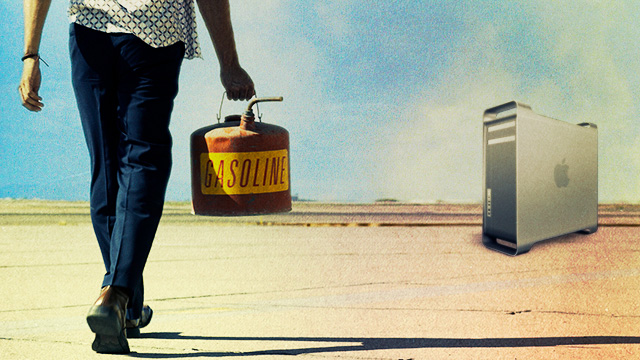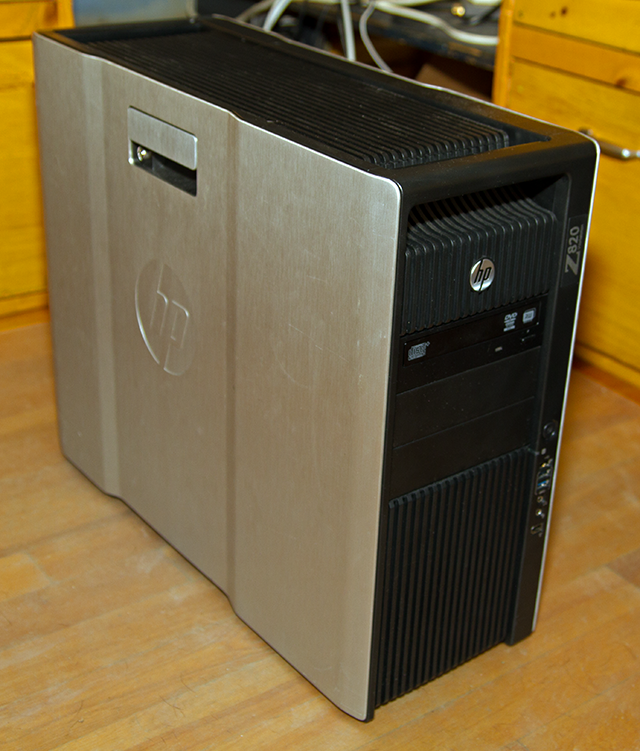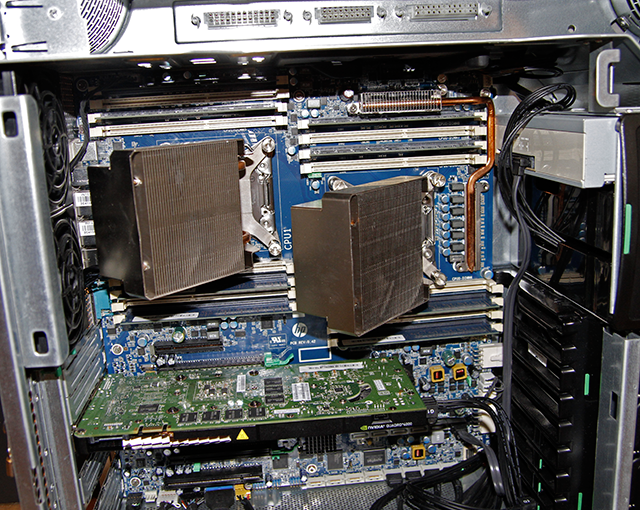
Like many Mac-based creative professionals, I followed this year's WWDC keynote anxiously, awaiting the "one more thing" that never came: an E5 Xeon refresh of the Mac Pro line. Its absence was brutally disappointing; thankfully, Tim Cook broke his vow of secrecy to reassure us that a new Mac Pro will arrive in 2013. But for filmmakers compressing hours of 4K footage or school labs in need of new Maya machines, that’s a long time to wait—perhaps too long. Since I was also in the market for a machine to help out with my V-Ray renders, I decided that the time had come to evaluate my alternatives. The current Westmere-based Mac Pro line is definitely out of sync with what’s available elsewhere, and it is no longer competitive from a price-to-power standpoint.
I have heard it said that Dell, HP, and Apple split the workstation market pretty much three ways; whether or not this is true, it did seem worth taking a look at how the other big boys’ hot-rods rolled. The HP Z820 and Dell Precision T5600 are both monstrous dual-socket Intel E5-2665 Xeons clocked at 2.4GHz and, if I had to guess, I’d say that they are much like what would have replaced the dual Westmere Xeon 2.66GHz Mac Pro that I reviewed in 2010.
Of course, you can still build your own workstation, but I’m writing this for an audience who needs top-tier support and doesn’t want to chase six different companies when something goes wrong. I have my own overclocked 3930K gaming rig dual-booting Linux and Windows, but as I’ve pointed out countless times in the comments section of my Mac Pro reviews, a workstation needs to do one thing: keep working. Vendor support remains key to making this happen.
That’s where the Mac Pro, Dell T5600, and HP Z820 come in. We'll start our cage match with the HP Z820... since it was the first machine to arrive for testing.
Review of the HP Z820
Specs as reviewed:
- Dual E5-2665/8 Core/2.4GHz with 20MB cache
- Intel® C602 chipset
- 16GB quad-channel RAM (16 DIMM slots total, 4 used in this config)
- NVIDIA Quadro 4000 2GB (1 dual-link DVI, 2 DisplayPort output)
- 500GB – Windows 7 Professional
- Dual-layer DVD-RW
- HP keyboard and mouse
Since you can get Linux for these machines instead of Windows 7, I also tested this machine with an HP-provided Redhat Linux boot disk. More on that later.
Standard Ports:
- 4 USB 2.0 on back, 1 on front
- 2 USB 3.0 on back, 2 on front
- 1 Firewire 400 on back, 1 on front
- 2 Gigabit ethernet on back
- 1 VGA out
- PS/2 keyboard and mouse on back
- Stereo output on back
- Headphones out on front
- Mic input on back and front
Expansion slots:
- 3 PCIe Gen3 x16
- 1 PCIe Gen3 x8
- 1 PCIe Gen3 x4
- 1 PCIe Gen2 x4
- 1 PCI
Price as configured: $6,840 with discount active at time of review
HP has a lot of high-end products, and the company is no stranger to content creators. For instance, its 30-bit Dreamcolor monitors are exceptional, and if you bought one of these monitors and hooked it up to a Mac Pro, you’d actually be throwing away color (Apple still hasn’t added support for 10-bits-per-channel color to OS X). My Z820 and Dell T5600 review units came with a Quadro 4000; both Nvidia and AMD restrict high-bit output to their pro line by means of their drivers, so both workstations can take advantage of these high-bit displays.
Unfortunately, I don’t own a 30-bit display, but the Quadro 4000 works fine with my dual NEC 2490WUXi monitors in both Windows 7 and CentOS 6.3.
The price tag
Before I cover the hardware and software features of the Z820, let's talk about that slight sticker shock. The first thing that jumped out at you about the Z820 was probably not its 32-thread CPU or giant cache—it was the price tag of $6,840, sans tax. We don’t tend to think of Mac Pros as "the cheap retail option," but workstation retailers like HP, Dell, and BOXX consistently come in at a higher price than the equivalently specced Mac Pro. This time around, the situation is obviously different, since Apple doesn’t even offer a Xeon E5 machine, but it is typical and there's a good reason for it: on-site support.
The HP Z820 and Dell T5600 both come with three-year on-site warranties, while the Mac Pro has one-year standard AppleCare (you can buy an added two years of AppleCare for $250). The difference is significant. AppleCare through a local Apple store or certified Apple repair outlet works well if you live in a major city and can afford a few days of down time, but an on-site warranty is like having a hotline to a dude ready to run out to your office to fix your problem the next day. It's meant to ensure minimum down time in case something goes wrong, like when a power supply fails.
This level of service adds a lot of risk to the profitability of a machine for workstation vendors. If you live in Cheesehole, Wisconsin—away from an HP- or Dell-certified repair guy—they will still put their dude on a plane to fix your computer, for three years, at no additional cost.
An on-site warranty is a standard in enterprise environments, and Apple says that AppleCare includes on-site coverage... but I’ve never once had them send a technician to my office in 20+ years of using Macs. They always tell you to bring the machine in, and even at large Apple stores, parts aren’t stocked, so there's at least a two-day down time for repairs.
On-site coverage is computer life insurance, and it’s expensive. Given that level of service, the $6,840 price tag of the Z820 is very reasonable; whether the added premium is worth it remains between you and your wallet.
The case
The Z820 was the first of the PC machines to arrive, and it instantly looked and felt like a solid workstation. It’s quite heavy and about the same size as the Mac Pro case, with about half an inch more in the width and two inches less in the height thanks to the front and rear handles being integrated into its 5U rack-mountable profile:

The front sports three optical bays, two USB 3 ports, one USB 2 port, a headphone jack, a mic input, and a Firewire 400 connector. It might seem funny for a new machine to incude such an old Firewire port, but it can come in handy for older DV cameras. (You can have the Dell T5600 configured with a 1394a card as well.)
Despite its heft, the Z820’s exterior is mostly plastic, with two solid metal sides. The plastic is not cheap-feeling and the finishing and tight coupling with the metal make it feel rugged and worth the money. When I look at the design of a workstation, I consider its resale value. When you sit next to a used Mac Pro with a prospective buyer, it’s easy for them to want—it’s beautiful, solid, and air-tight. The Z820 is what I’d imagine a competing case would look like.
Once you crack open the case, the Z820 continues to impress. The four 3.5" drive bays are stacked at the front of the unit, which I found really helpful when doing some swapping and rejigging:

The toolless HD mounting brackets of the Z820 are nice, and have a firm snap-and-lock mechanism for setting them securely in place within the drive bay. As in the Mac Pro, you can have drives resting harmlessly in the bay without being connected. The plastic brackets felt a bit flimsy at first, but they were fine even with a lot of disk swapping. It does seem a little weird that a newer workstation wouldn’t have SSD mounts, but my Icy Dock SSD-to-HDD enclosure fit fine in one of the bays.
Full-size ATX fiends will whine about how four drive bays are too few, but my Corsair 550D and its four optical drive bays (three empty) and six hard drive bays are overkill—and of dubious value considering the 550D is designed for low noise and heat. Video professionals will have external RAID arrays connected to PCI cards or by Thunderbolt, not a bunch of disks inside their machine. The smaller size is more portable and lowers the overall heat of the PCs, so I prefer this approach. But you do need a balance between expandability and size, and the Z820 is right in the sweet spot in my opinion.
The PCI slots are easily accessible and cable management is exceptional. There are no screws for the PCI cards—they get locked in place by a small door that closes when the case is shut. Smart, time-saving features like this are something you will appreciate if you’re upgrading a lab of these. Once you take off the PCI and mainboard compartment doors, all the RAM is easily accessible:

The Z820 has 16 DIMM slots, twice that of the current Mac Pro, so presumably you could upgrade it to 128GB with 8GB chips vs. 64GB total for the Mac Pro (which would be a bad idea anyway, because the Mac Pro uses triple-channel memory). But honestly, I don’t see this as a huge advantage. I do 3D for print (high res 32-bits-per-channel images) and run virtual machines and almost never page out with just 24GB. Nevertheless, if you need a ridiculous amount of RAM, the Z820 will accommodate it.
The power supply is modular and easily pulled out by a similar handle and snap-bracket that the hard drives have. This is clearly a machine that's well-engineered from head to toe. MORE


